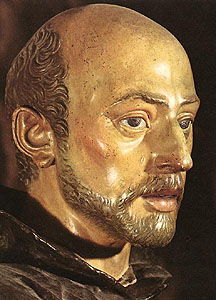SE Introduction: Session Eight.
Ask God our Lord for the grace that all my intentions, actions, and operations may be ordered purely to the service and praise of the Divine Majesty. St. Ignatius of Loyola (SE 46)
I’ll be gut honest here. I can’t tell you all the saints without a program!
And before entering into training to become a spiritual director in 2013, for me, the Saints played in New Orleans, and Loyola was merely a college located on North Sheridan Road and a popular “L” stop as you wind your way on the train from Evanston into the Loop of downtown Chicago.
Ba-boom.
But now, all these months later, I find myself desiring to follow a code of ethics and a Christ-centered lifestyle that the early Jesuits (a gathering of godly men first founded by Ignatius of Loyola back in the sixteenth century) defined as “contemplatives in action.” Today, many in the twenty-first century call the life and ministry of these early Jesuits “contemplative activism.” And as you can see by our website’s name, I really like that term…The Contemplative Activist.
My spiritual director, Dr. Micha Jazz, defines it this way:
Let’s remind ourselves that contemplative activism combines two ideas, the first one being the essential, yet often lost art of drawing aside with God for prayer and learning how to find Him in every aspect of life. Contemplative experience provides a door to discovering so much more about ourselves, each other, God and His ways.
However there is a danger having ascended the heights through contemplation, that we may not want to return and make our descent back into the streets of chaos within which we are called to carry out the mission of God. Secondly, therefore, we seek to live out prayer by rolling up our sleeves and serving the needs of the surrounding community. The contemplative activist develops the rhythm of ascent and descent in living the Spirit filled life.
You see, when Ignatius formed his first band of brothers in 1537, calling them “The Company (or Society) of Jesus,” they dared to take the name of Jesus of Nazareth, which no other religious order had ever done, for the simple reason that knowing, loving, and serving Jesus Christ was the inspiration and end of their mission together. As Kevin O’Brien states in his book, The Ignatian Adventure, these Jesuits “wanted to be companions of Jesus carrying His cross” with their motto “Ad Majorem Dei Gloriam,” a Latin phrase that translates “for the greater glory of God.”
For Ignatius and the Society of Jesus, the primary instrument to discern God’s call in their lives was the Spiritual Exercises. Through the Exercises, which can be practiced today over a period of several days, several weeks, or even months, the early Jesuits believed that followers of Christ can truly grow in faith, hope, and love as they give themselves over to the work of the Holy Spirit during extended times of waiting on and in God’s presence. In and through the Exercises, Ignatius believed, young and old alike can prepare for and sustain themselves in the service of God and others. As O’Brien states it, “More than a book, the (Spiritual) Exercises (of Ignatius) are an experience, a great adventure to the heart of God and, therefore, to the real and present needs of the world.”
So, folks, even though the Saints still play in the City of Jazz and Loyola is one great place to study the arts and sciences, I, for one, am ready to follow the trail of the early Jesuits. In the days ahead, we’ll explore ancient disciplines like Lectio Divina, the Examen, the Jesus Prayer, and much, much more. Contemplative activism, anyone?
Next stop. Ignatius of Loyola.
My prayer: Father, thank You for the ways in which You have worked with Your people for generations. The dates and locations may change, but You don’t. May I learn the fine art of contemplative activism, developing the rhythm of ascent and descent in living the Spirit filled life. For Your name’s sake. Amen.
My questions to ponder: What ancient truths practiced by saints of old need to be restored into my contemporary life? How have I failed to recognize these ancient disciplines and what might it look like for me to bring some of these tried-and-true Christ-centered practices into my life today?
So what is God speaking to you today as we ponder together The Ignatian Adventure?
Over an eight month period, you and I will be working our way through the Spiritual Exercises of Saint Ignatius. For more information on our journey and how to begin…click here!
To go onto the next journal entry…click here.

